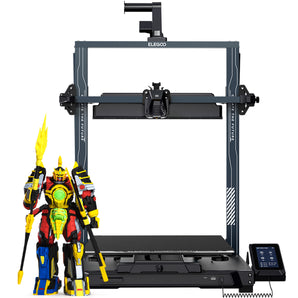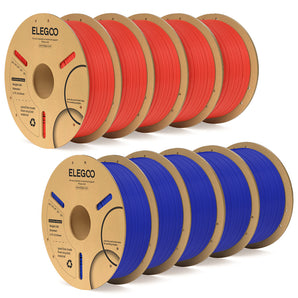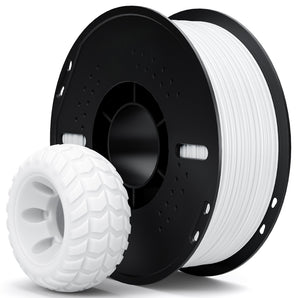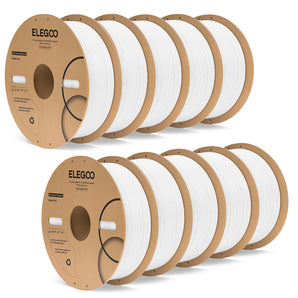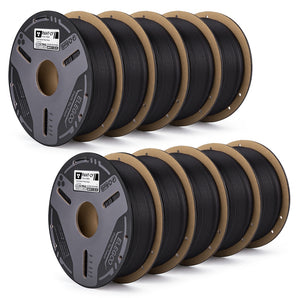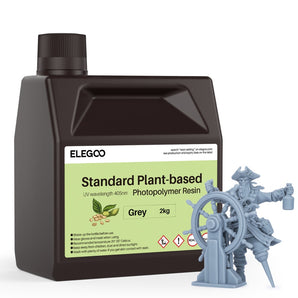
The use of 3D printing technologies has come a very long way over the years to become one of the most convenient manufacturing processes known to man. As the widespread use continues, it is becoming cheaper as time goes by, and now, anyone can get their hands on a 3D printer and its related technologies way cheaper than before.
But how does a 3D Printer stack up against a 3D Pen?
We are going to explore what 3D Pens and 3D Printers are, how each functions, the differences between the two, the benefits and limitations of each, as well as the best versions of them that are currently making rounds in the market. If you have been curious to know more about these two, then you are in the right place.
What is a 3D Pen?

This is a pen-like structure that could be passed off for a regular pen by design. The only difference is that it appears a little bulkier, and it doesn’t use ink or function as a normal pen would. It uses something called a filament made of a special plastic that melts and oozes from the tip through an opening.
For most people who are familiar with 3D Printers, a 3D Pen looks like a miniature version of the former. When it comes to working with 3D Pens, they are much easier to control and don't require any complicated training or mad skills to be able to use them correctly. All you have to do with a 3D Pen is to load the filament, get to the desired temperature, and the filament starts oozing from the pen, solidifying instantly once you have created the pattern you were looking to create.
Another stand-out feature of the 3D Pen that makes it different from other alternatives is the fact that it doesn’t need any software to run. You simply control everything with basic buttons. As long as the filament is loaded up and the source of power is linked to the pen, you are free to use it how you want.
How a 3D Pen Works
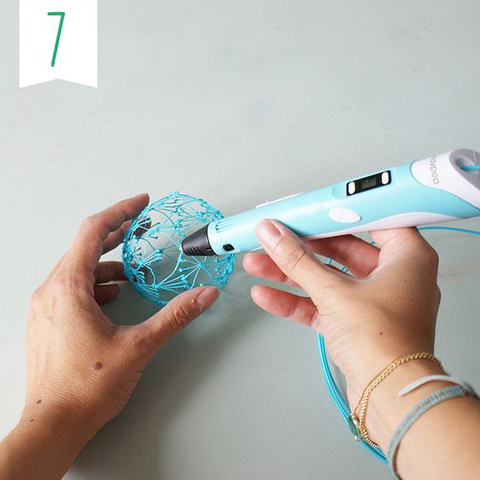
When it comes to 3D Pens,There are two main processes that are involved, and this depends on the nature of the pen. 3D Pens can be grouped into two main classes; Hot Pens and Cold Pens. These variations are discussed below in detail.
- Hot Pen: A filament plastic is loaded into a hot pen and, as it passes through the inside of the pen, is subjected to an intense heat that makes it melt into a free-flowing goo. The temperature has to be right for this process to make the place, any hotter and it could destroy the filament, causing an erratic modeling process. The softened filament then oozes from the tip of the pen and is now used for drawing as independently standing lines that can be set up even in the air. Most of the common plastic materials that are used for Hot Pens are ABS and PLS, and the technology used is the same as the one found in FDM 3D printers.
- Cold Pen: This pen makes use of a chemical process that is used to solidify a liquid resin on the spot once the two come into contact. This happens as the resin oozes out of the pen. The resin in question is not like any other. It is a photosensitive resin that is mixed with special chemicals, solidifying instantly when it is exposed to light. This is how cold pens are able to avoid using heat completely when it comes to making all kinds of 3D art.
How to Use a 3D Pen
As we have already mentioned, using a 3D Pen is not that complicated, and anyone who has ever come face to face with any 3D printing process will automatically figure out its operations within minutes. The following is a step-by-step guide on how you can use a 3D Pen.
- Select a Pen: There are many types of 3D Pens, and each of them is designed for creating models quickly. There are many factors that you have to consider when finding a good pen. The bottom line is that the pen you choose must suit your hand well, and it should be easy to operate without any external help.
- Set up the Pen: The pen doesn’t come out of the box ready to use. It has to be configured the right way, depending on the type. The following are the quick steps you have to follow to get it working.
- The pen has to be plugged into a power source and power it on.
- You have to select a filament that is compatible with the pen.
- This is followed by setting the right temperature if you are using a hot pen. Give it a moment for it to heat up sufficiently. Watch out for the indicator light.
- Insert the filament into the right input port. Make sure the entry area is flat to avoid any jamming problems.
- Select the speed setting based on what you want to make. This is important because the material solidifies the instant it comes into contact with air. You have to be fast.
- Start Making 3D Sketches: With everything set up, it is now time to start making your 3D sketches. This could be based on drawings you already made, or you can make everything from scratch. Begin by extruding a small bead of the resin on the platform to act as the anchor point for the rest of the model.
Materials used for 3D Pens

There are a number of materials that are used for the filament when it comes to 3D Pens. These materials have unique attributes that make them ideal for certain functions over others. The most commonly used materials include the following.
- ABS: Acrylonitrile Butadiene Styrene is the most commonly used material in 3D Pens, and it can be found easily in any shop. It is strong and easy to control, but it comes with some undesirable sides to it. For instance, it requires very high temperatures to melt, and this means the pens used have to be the type that can withstand high heat. This also leads to fumes being emitted in the process, and people who use this have to wear masks and glasses to avoid respiratory complications.
- PLA: Poly Lactic Acid is an eco-friendly plastic material that is derived from natural sugars like cor and cane. It is safe and biodegradable, and it doesn’t require high temperatures to melt, and neither does it emit any dangerous fumes. The drawback with using PLA is that it takes too long to cool, and this can destroy what you are making.
- PCL: Polycaprolactone is another common material used for the filament in 3D pens. It comes with a low melting point, and it can even be reshaped by hot water. This also makes it easy to use as it solidifies much faster. Most 3D Pens that are designed for kids use this for the filament. The drawback is that it degrades too fast, and it cannot be used to make prints that last for very long.
- PA: Polyamide, or better known as nylon, is what you go for when you want to make long-lasting and durable 3D models using a 3D Pen. It is very strong and flexible at the same time, a rare combination. The only drawback is that it requires high temperatures for the filament to melt down.
Applications of 3D Pens

3D Pens bring a high level of convenience to people who love creating art and this has further pushed their popularity much higher. The following are some of the most common applications of 3D pens today.
- 3D Printing Repair: 3D Pens work very well when combined with 3D Printers. They can be used to make repairs on 3D printed models in case of minor defects. Since you can’t return a complete model back into the 3D printer, you can easily pepper over the damaged, part with a 3D pen in minutes.
- Making Art: 3D pens are very handy when it comes to making customized hand art. You can hold them like regular opens, and this allows the user to recreate anything from scratch just as they would when using a paintbrush. This is why artists love 3D pens.
- 3D Design and Prototyping: When it comes to quick product development blueprints, 3D pens are the best options. Since they don’t require any complicated work, one can use them to quickly create prototypes within hours, and this helps designers to better conceptualize their ideas.
- Learning Tool: 3D Pens have made the learning process easier and more fun. Subjects like mathematics have become easier to teach through the use of 3D models that better illustrate concepts for the students to grasp. They are also used in architecture and science with great success.
What is a 3D Printer?

Source: https://pixabay.com/
A 3D Printer is a machine that is used to make 3-dimensional objects using plastic material, an executable digital file, and a modeling program. It is one of the most advanced forms of manufacturing that puts the control in the hands of the person running it. There are so many types of 3D Printers being used today in the manufacturing world.
The process used to achieve 3D Printing is called the additive process, and it involves the laying down of layers upon layers of material until the final object emerges later on. The layers are everything, and this ensures that they are compact and glued to each other before the solidification process begins.
3D printing has made it possible for some complex products to be made from scratch, something that used to be very costly in the past. As the technology behind 3D printing continues to grow, the machines are becoming cheaper, and people can now have them installed in their own homes for their creative needs.
How a 3D Printer Works

Source: https://pixabay.com/
A 3D printer is more sophisticated than a 3D pen and operating it requires people who are well trained for the job. There are certain important printer components that have to be present for a 3D printer to work.
The process begins by installing a good 3D program that can be used to both create the model to be printed and, at the same time, send the instructions to the printer to start executing the file. The designing parts are usually the most time-consuming parts as everything has to line up perfectly first.
The biggest advantage of using 3D designing programs is that you get the chance to see how the final product will look before the process begins. These simulations will give you a clear picture of the changes that are supposed to be made. This allows for better designs and less wastage of raw materials.
How to Use a 3D Printer

Source: Elegoo
For you to use an advanced 3D printer, there are some preparations that have to be made in order for the process to be a success. These come in the form of simple steps that are easy to execute even without any external help. They include the following.
- Preparing the Built Plate: This is the platform upon which the materials will be placed on during the printing process, layer by layer. You have to prepare the surface for the printing process to work. This includes cleaning it to make sure it is free of any contamination. This is followed by the application of a special spray that will stop the layers from permanently sticking to the surface.
- Heat the Printer: Most 3D printers rely on heat for them to work. The plastic material being used has to be melted down to a viscous material that can then be dropped onto the plate in uniform layers. The filament material that is frequently used in 3D printing is PLA. Know the specific heating requirements for each raw material that you use to avoid overheating or underheating them, as that will affect the final product.
- Load the Filament: Once the printer has attained the desired heat, it is time to load the filament. Before doing this, check the extruder to ensure that it is clean and doesn't have any plastic remnants from a previous batch. Once you are sure everything is clean, load the filament and get ready to start printing.
- Level the Bed: The bed has to be straight, and level or this will affect the stability of the product. The layers are lined up over each other based on the alignment of the platform. If it is slanted, the layers will be slanted, and this will be visible when you are done printing and you notice the model looks lopsided. Check to see that the bed is as straight as possible.
- Start Printing: Once you have leveled the bed, it is now ready for the printing process to begin. Depending on the material use and the size of the product you are making, this process could take anywhere between half an hour to long hours. Just make sure that the process is not interrupted.
Materials used for 3D Printing

Source: https://pixabay.com/
There are certain plastics that are used for making 3D Printer filaments. These plastics come with varying properties for different types of tasks. The following are some of the most commonly used plastics in 3D Printing.
- Resins: 3D Printer Resins come in varying types and are used for a wide range of models in 3D printing. You can either use high-detail resins, which are used for smaller models that need intricate detailing. You can also use paintable resins that have smooth surfaces that are easy to paint over. The last type is a transparent resin which is the strongest and is used to make durable products that are smooth and transparent.
- ABS: This is another commonly used plastic type that is loved for its durability and strength. It is particularly loved by home-based 3D printers owners as they are cheap to source. The only disadvantage is that it requires very high temperatures to melt down, and it uses a lot of power.
- PVA: Polyvinyl Alcohol Plastic is mainly used in low-end printers as it is of lower quality. It is mostly;y used to make products that are for one-time use only, not the kind that requires a lot of strength or heavy use. Just the type that is for temporary use before discarding.
- Polycarbonate: This is rarely used for 3D Printing unless it is necessary. It is a hard and brittle material that is used for 3D printers that come with nozzle designs and those that require very high temperatures to operate. Polycarbonate is used to make low-cost plastic products and trays used in molding.
- PLA: PLA is the most preferred material for 3D printing processes, and there are good reasons for this. It is derived from natural sources like corn and cane and has a very low melting point which means you use less electricity when making 3D models out of PLA. However, the cooling process may be too long, and the fact that it is biodegradable means the model gets destroyed easily when exposed to the elements.
- Polyamide: This is nylon, another widely used plastic material in the 3D printing process. Nylon is easy to access and is cheaper than most of the other products on this list. It is mostly used for making solid products that are used for high-strength roles. You will find it in cars, toys, and heavy machinery.
- Alumide: Alumide is made by combining polyamide and gray aluminum powder. This is for the purpose of adding strength to the kix in order to make stronger and more durable plastic models. Alumide is used in the 3D printing of industrial prototypes.
Applications of 3D Printing

Source: https://pixabay.com/
There are so many applications of 3D printing and newer ones are being found each day. As the technologies behind the process continue to improve, the printers are becoming cheaper, and this is increasing access, and with this, people are getting more creative. The following are the most notable applications of 3D printing.
- Education: The more accessible 3D Printers get, the more advanced the education system becomes. Teachers and schools are now able to create models of what they teach to make students understand things better. From creating models of chemical bonds, geometrical shapes, and architectural designs, students are able to grasp concepts much faster by using these models.
- Prototyping: Back in the idea, the process of prototyping used to cost manufacturers a lot of money as it had to rely on complicated machinery and experts to simply create something that was not even that refined. This cost them a lot of money. But 3D printing has made that process cheaper and accessible to all manufacturers. Prototyping is now cheaper and easier to handle without any added cost.
- Medical World: 3D printing has made it possible for whole parts to be created from scratch to be used as prosthetics. This has greatly increased efficiency in the medical world as people can now make tools that can be customized to the needs of the patient. At the same time, 3D printing has been used to create medical equipment that is more accurate and safer for use. This has boosted healthcare.
- Construction: House fabrication involves the building of homes by combining different parts that are manufactured independently. This process has been taken over by 3D printing as it is more accurate, and it can be scaled up or down depending on the needs of the clients. This has also brought down the cost of construction, and eventually, as the technology continues to grow and expand, people will switch to using 3D printing for most of their construction needs.
- Art and Jewelry: Artists are turning to 3D printing to make their art better and more prominent without having to go through the hoops of spending too much time. All they have to do is create the blueprints that are then executed by the printing machine, and they have their art within hours. On top of reducing the production times, this has also opened up a new world where artists are able to tap into their creative pool to create complex structures that couldn’t have been possible with any other process.
- Automotive Industry: There are some delicate parts of the car that have to be made with great care for the vehicle to work. These parts range from gearboxes, steering wheels, among many others. Modern car makers have been making use of 3D printing to manufacture these parts in huge volumes to save money and increase precision.
Conclusion
3D Printers and 3D Pens are both highly advanced technologies that are changing how people manufacture things. They have made it easy for people to tap into their creativity from the comfort of their homes and make items that help them in their day-to-day lives. For more information on how these pens and printers are made and how they operate, check out our website and have all your questions addressed by our team of experts.




























